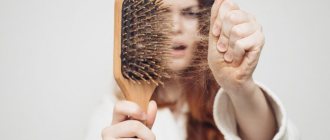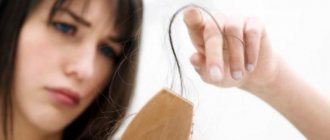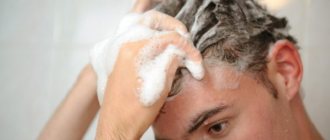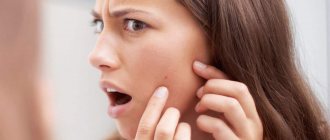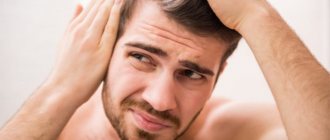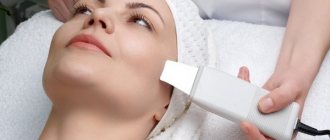- March 17, 2019
- Hair treatment
- Yana Yakovenko
Alopecia is pathological hair loss. This condition differs from male pattern baldness due to the uneven hair loss. Characterized by complete or partial loss of hair in certain areas of the head. Compared to male pattern baldness, it is less common, but it is a fairly serious problem. At an advanced stage, alopecia in women can cause complete hair loss.
The problem occurs in 30% of the fairer sex. These are women aged 25 to 45 years. However, it has been noted that alopecia is often diagnosed after 40. In men, baldness is much more common, but not all of them respond to this problem, while for women, hair loss is a real disaster at any age.
Reasons for appearance
They are numerous, so it is extremely important to see a doctor and get tested so that he can create a complete picture of the condition of your body. There are also completely harmless causes of alopecia in women - frequent drinking of alcohol and large doses of caffeine and nicotine. If you give up these bad habits, the situation will normalize.
Also, the causes of alopecia in women are as follows:
- Development of scalp fungus. It causes the appearance of alopecia areata.
- Lack of zinc and other important micro- and macroelements. In this case, there is also a deterioration in the condition of the skin and nails.
- Pregnancy, breastfeeding period. In this case, the nutrients entering the body are almost completely absorbed by the fetus. Hormonal changes also occur, which negatively affects the skin and nails. The woman also constantly suffers from fatigue. All this together can cause alopecia.
- Thyroid diseases. Since it produces hormones that affect the functioning of our entire body, disruption of its functionality leads to numerous symptoms. This may be alopecia, cracks in the skin, drowsiness, “waves” on the nails.
- Frequent stress and nervous system disorders. Due to deterioration of blood circulation in the vessels of the brain, the follicles receive less nutrition, which is why hair begins to fall out.
- Iron deficiency anemia. Lack of hemoglobin is often a consequence of excessive physical exertion and amenorrhea. It often occurs among lovers of “proper” nutrition, who sometimes do not receive enough micro- and macroelements from food.
- Any chronic disease worsens the condition of the hair over time. This could be intoxication of the body, rheumatoid arthritis, lupus erythematosus, infections such as syphilis and tuberculosis.
- Polycystic ovary syndrome. In this case, the body experiences a lack of estrogen and an excess of testosterone, which has an extremely negative effect on the condition of the hair. Also, an excess of testosterone is observed with pituitary hyperplasia, proliferation of the adrenal cortex, and taking steroid drugs.
- Some medications that need to be taken for a long time. These are hormonal contraceptives, laxatives, antidepressants, anabolic steroids, drugs for weight loss and cancer. Aspirin can also be included in this list.
- Frequent cosmetic procedures. Dyeing, blow-drying, perming and other procedures have an extremely negative impact on the health of the hair. With regular thermal and chemical damage, hair begins to fall out very quickly.
- Hypothermia of the scalp, resulting in vasospasm.
- Radiation therapy, burns.
- Alopecia can also be hereditary, but this is quite rare. Often occurs in children. In this case, atrophy of hair follicles is observed in all areas of the scalp. Also, this condition is often accompanied by other pathologies. A characteristic feature of hereditary alopecia is its presence in several family members.
5Causes of baldness in women
There are many reasons why alopecia develops in women. We list the main ones:
6
Heredity
Genetic predisposition consists in inheriting a certain DNA locus, which encodes the increased susceptibility of hair follicles to testosterone, and also predisposes to pathological biochemical processes in the deep layers of the skin and dermis. The consequence of these processes is hair loss.
7Hormonal disorders
Insufficient amount of female sex hormones - estrogens, and excessive production of testosterone. These conditions can occur with diseases of the genital organs, polycystic ovary syndrome, tumor processes in the ovary, uterus, and hypothalamic-pituitary disorders. Menopause, pregnancy, lactation are conditions in which there is a fluctuating hormonal background and a high risk of developing pathological disorders. They can lead to hair loss on the scalp.
8Diseases of the glands
Diseases of the endocrine glands: thyroid, adrenal glands, pituitary gland, parathyroid glands. Metabolic disorders develop, resulting in the formation of protein deficiency, disturbances in the exchange of micro and macroelements - selenium, zinc, magnesium, sulfur, which are so necessary for hair growth.
9Diseases of the gastrointestinal tract
Diseases of the gastrointestinal tract - can lead to impaired absorption of nutrients and microelements in the intestine, a disorder in the synthesis of vitamin B12, and internal factor Castle.
10External negative influences
Exposure to harmful ionizing radiation, radiation, the influence of chemotherapeutic drugs (cytostatics in the treatment of cancer, glucocorticosteroids, contraceptives, antidepressants, non-steroidal anti-inflammatory drugs).
11Head injury
Scalp injuries: exposure to physical, thermal, mechanical agents. Excessive passion for styling hair in women using hot irons, curling irons, and bleaching the roots with perhydrol can become a trigger in the pathogenesis of baldness.
12Autoimmune problems
Systemic autoimmune disorders: systemic lupus erythematosus, rheumatoid arthritis, sarcoidosis, amyloidosis. In these conditions, autoimmune complexes circulate in the human body, aimed at destroying their own cells, including hair follicles.
13Inflammation and fungus
Purulent inflammatory processes in the scalp caused by pathogenic flora: Staphylococcus aureus, Pseudomonas aeruginosa.
Pseudomonas aeruginosa
- Fungal processes.
- Disturbances in the innervation of the scalp - provoke microcirculation disorders in the hair growth zone - blood circulation in the area of the hair follicles.
- Acute and chronic stressful situations, infections in the nasopharynx, enlarged cervical nodes help maintain the pathology of sympathetic nervous regulation and increase peripheral vascular spasm. Blood stops flowing to the follicles and nourishing them. The result is loss of scalp hair in women.
It is not always possible to identify the cause of the development of alopecia in women. If a clear relationship between the provoking factor and baldness is not identified, the doctor makes a diagnosis marked alopecia “unspecified.” Still, it is worth striving to identify the etiological factor that caused baldness. After all, success in the treatment of baldness, activation of hair growth, restoration of the physical health and psychological comfort of a woman depends on its elimination.
Stages and their symptoms
Each hair goes through three stages in its development - active growth (2-4 years), an intermediate phase when it stops growing, but the cells of the hair papilla in the follicle are still functioning (15-20 days), and complete cessation of growth (1-3 months ), when the old hair eventually falls out, pushed out by the new one. 93% of hair on the human body is constantly in the growth phase, 1% is in the resting phase and 6% is preparing to fall out. The growth cycle is repeated approximately 25 times.
Experts say that losing up to 100 hairs per day is normal. If violated, a woman begins to lose up to 1000 hairs. It is this intense hair loss that can lead to baldness.
Signs of alopecia in women depend on the stage. There are only three of them. The disease begins with thinning hair in the parting area.
- At the first stage, thinning is observed near the forehead and in the parietal area.
- The second is characterized by moderate hair loss.
- At the third stage, noticeable thinning of the hair on the crown occurs. The hair remains at the temples, but it is much sparser and thinner than it was before.
Causes of autoimmune alopecia
The reason for the body’s cellular aggression directed at its own hair cells remains a mystery to this day; the following versions have been put forward:
- A defect in immunoregulation that occurs in childhood and is inherited. Geneticists suggest that this is due to the HLA gene, which is located on the sixth chromosome and is responsible for protein coding. This protein, with the help of immune cells, helps to “calculate” antigens and the body’s own cells; without it, the immune system begins to confuse them. Mutations in this gene can lead to insufficient production of this protein.
- Often, autoimmune alopecia begins after infectious diseases; a connection between alopecia and atopic dermatitis and other skin dermatoses has been noted. This confirms the immune theory: the introduction of an infectious agent can provoke an immune reaction with subsequent autoimmune development. This also applies to foci of chronic infection (sinusitis, tonsillitis, caries), which can disrupt the calm of the body’s immune system and force it to constantly produce antibodies.
- Disturbances in the functioning of the endocrine system can also provoke the development of the disease; when examining alopecia, they can reveal autoimmune thyroiditis - inflammation of the thyroid gland.
- Various autoimmune diseases - systemic lupus erythematosus (SLE), Still's disease and others.
- A stress factor influences the formation of autoimmune alopecia, but it is currently not possible to explain the mechanism of its action.
The levels of immunoglobulins in patients change, so this proves the participation of autoimmune components in the development of baldness, but it cannot be argued that they are the root cause of the destruction of the hair apparatus.
But at the same time, all patients with GA, without exception, have immunological changes.
For correct diagnosis, you need to visit a dermatologist, trichologist, endocrinologist, immunologist.
Types of alopecia in women
There are 3 types of alopecia. Let's look at each of them in more detail.
Alopecia areata in women is rare, as reported by statistics. However, in practice, doctors often diagnose this particular type of baldness. The disease occurs suddenly. Hair begins to fall out locally, forming round or oval patches of bare skin. The lesions can be multiple, but often there is only one. In areas of hair loss, the skin turns red, itching and burning appear, and at first you can see holes left in the place of the fallen follicles.
There are several types of alopecia areata in women:
- subtotal;
- with one hearth;
- with numerous foci;
- total;
- nesting
At the last stage, hair falls out all over the body. In parallel, the disease also affects the nails. It often occurs due to hereditary predisposition under the influence of associated factors.
Androgenetic alopecia in women is a congenital pathology. It often begins to appear during hormonal changes in the body. It is characterized by a wave-like course: at first the hair falls out very quickly, then this process stops - and everything repeats again.
A characteristic symptom is rapid greasy hair. In place of those that fall out, new ones grow, but thinner and almost colorless. In women, androgenic type alopecia appears by the age of 30 and is characterized by uniform hair loss in the parting area.
Scarring alopecia occurs as a result of trauma to the scalp. Individual pockets of bare skin with traces of damage appear. Nearby there are areas of skin with broken or even completely intact hair.
Diffuse alopecia is also called symptomatic. Often the moment when intense hair loss began is easy to trace. The process can begin after severe stress, pregnancy, poisoning, taking medications, or diet. Hair falls out intensively and evenly throughout the head. At the same time, in the crown area, the outline of bare skin resembles the letter I. Baldness is also observed in the area of the frontal part and temples.
Causes
Scarring alopecia, characterized by an irreversible process of hair loss, is caused by:
- Genetic predisposition. This includes diseases such as ichthyosis and aplasia.
- Diseases of an autoimmune nature (lupus erythematosus, scleroderma and others).
- Some infectious diseases.
- New growths on the skin, cancer.
- Injuries, burns of various origins.
- Cell death associated with metabolic disorders.
Often the strands fall out along with the white tips. These are weakened follicles or roots that have ceased to perform their function. New ones may form in their place, but this will not happen soon.
To understand why your locks are thinning, rule out the most common causes of non-scarring forms of alopecia. These include:
- Hormonal disorders. Hormone levels are affected not only by pregnancy or age-related changes (the picture at 20–30 years old is completely different from that at 40 or 50). but also some diseases. For example, polycystic ovary syndrome.
- Deficiency of vitamins and microelements. It is not enough to get them from food or special medications - it is important that all components are properly absorbed.
- Problems with the thyroid gland often lead to alopecia.
- Digestive problems that interfere with the good absorption of nutrients also provoke hair loss.
- Anemia accompanied by iron deficiency.
- Chronic infections can eventually cause alopecia.
- Stresses that provoke vasospasm, and as a result, poor blood supply to the hair follicles.
- Some medications also cause hair loss. These include antibiotics, hormonal agents, antidepressants and other drugs.
- Beauty procedures: frequent coloring, perm, permanent complex styling.
- Skin ailments: seborrhea, lichen.
- Influence of environmental factors. Radiation or extreme cold are not comparable in terms of their impact, but are equally causes of hair loss. Also, curls sometimes fall out because the water you wash your hair with is too hard.
- Improper hair care. This includes choosing low-quality cosmetics for strands (for example, with a large amount of alkali), as well as frequent use of styling, traumatic combing, wearing tight elastic bands and hair clips, and avoiding hats. If the cap is tightly attached to the curls, this impedes blood circulation in the dermis and disrupts the flow of oxygen, which can lead to further hair loss.
- Poor nutrition, which is low in vitamins and minerals, leads to gradual alopecia.
- Abuse of bad habits.
- Season. Hair loss occurs more often in winter and spring, when the body experiences nutritional deficiencies. Still, fresh fruits and vegetables mean a lot for the beauty of hair and the prevention of alopecia.
By the way. Sometimes the cause of severe hair loss is fungal diseases. Get the appropriate tests if the strands break, the skin in the bald area turns red and itches.
Importance of diagnosis
It is extremely important to determine the causes of baldness. Otherwise, treating symptoms will not stop the process completely. If your hair is thinning intensively for several weeks in a row, this is a reason to consult a trichologist. He will prescribe the necessary studies. What tests do women undergo for alopecia?
In case of baldness in women, the trichologist first of all sends the patient for examination to a gynecologist and endocrinologist. Men are immediately referred to a gastroenterologist or neurologist. Patients are recommended to have an ultrasound of the thyroid gland and undergo a general and biochemical blood test. The latter will show whether the kidneys, liver, and pancreas are functioning normally. You definitely need to get tested for thyroid hormones. The following indicators are important: TSH, T3 and T4, FSH, LH, prolactin, progesterone, free testosterone, DHEA-S (a hormone produced by the adrenal glands).
Causes of pathology
With this type of alopecia, the root system of the hairline is inhibited at the cellular level. The immune system attacks hair follicles, perceiving them as foreign elements. The hair structure is damaged and the process of formation of new follicles is disrupted.
The reasons that provoke this pathological process are:
- hormonal imbalances (lack of testosterone in men);
- genetic predisposition;
- retinoic acid metabolism disorder;
- uncontrolled use of hormonal drugs;
- mechanical violation of the integrity of the scalp.
Important! Women are more at risk of developing autoimmune alopecia. This is primarily due to hormonal imbalances and the functioning of the thyroid gland. Quite often, this type of baldness develops in women during the postpartum period.
The immune system of men is less susceptible to autoimmune activity, which is why this type of baldness in men is diagnosed less frequently.
Alopecia in women - what to do and how to treat?
Statistics report that every third woman in the world will one day face the problem of hair loss. After eliminating certain factors, such as seasonality or hair loss due to diet, the problem resolves on its own. Other reasons require additional assistance to the body.
Unfortunately, our hair acts as a kind of indicator that signals diseases of internal organs that have not yet made themselves felt. Many ladies try to restore their hair using cosmetic procedures. If your hair loss is caused by coloring or frequent use of a hair dryer, this may help.
Treatment
Depending on the type of alopecia and the individual characteristics of the patient’s body, a treatment regimen is developed.
Drug therapy
Taking medications from the following groups will help heal the skin and stop hair loss:
- Sedatives - normalize the psycho-emotional background.
- Vitamin complexes - saturate the body with missing vitamins and microelements.
- Drugs that normalize blood supply to tissues.
- Means that normalize hormonal levels. The hormonal drug Diprospan has proven itself to be positive. It is administered subcutaneously over the affected area. The drug has an anti-inflammatory effect. Diprospan is indicated for many diseases that provoke alopecia in women. The average cost of the drug is 200 rubles.
Physiotherapy
Without resorting to drastic methods, you can restore the natural thickness of your hair in the following ways:
- galvanization - low voltage current is applied to the skin;
- electrophoresis - feeding the skin with necessary substances under the influence of direct electric current;
- darsonvalization - activation of the hair growth process through magnetic vibrations;
- cryotherapy - exposure of affected areas to liquid nitrogen.
Massage
In combination with other treatment methods, experts recommend massage. It has a beneficial effect on the growth of new hair follicles. The massage is performed using essential oils with your hands or a special comb.
Hair transplant
A situation in which it was not possible to restore the hairline with medication can be solved by resorting to a radical method - hair transplantation. The patient may be offered a transplant from the donor area, scalp reduction followed by suture correction, or expander plastic surgery.
Only a doctor can decide on the appropriateness of a particular treatment method.
With timely diagnosis of alopecia, the chances of complete hair restoration are maximized. It is important to strictly adhere to all doctor’s recommendations - both therapeutic and preventive.
Alopecia due to thermal and chemical effects - treatment
To restore volume and thickness to your hair, you should pay attention to medicinal cosmetics and traditional medicine. In particular, they can help:
- shampoos;
- masks;
- vegetable oils.
It should be noted that vegetable oils are considered very effective in the fight against alopecia. Indian women (who often have voluminous, shiny hair) widely use oils for scalp massage, for example, bhringaraj, brahmi, and amla herbal oil. Or at least coconut oil, even in its pure form. Olive, burdock, almond or grape seed oil are also suitable. However, such procedures quickly wash off the dye, and it is also very difficult to wash your hair after using them.
Essential oils are even more effective. In 1998, a study was conducted in Scotland in which subjects used a special oil composition. It included the following components: ethers of thyme, cedar, lavender, rosemary, as well as base oils of grape seed and jojoba. As a result, scientists determined that half of the subjects showed improvements.
How to cure alopecia in women, which is caused by exposure to chemicals? It is recommended to use masks made from natural ingredients. They need to be applied half an hour before washing your hair. Making such a mask is very simple at home. It may contain egg yolk, red pepper, sour cream, kefir, mustard and other components.
What can you do at home?
How to treat baldness in women at home? Methods to combat alopecia that can be successfully applied at home:
- traditional methods;
- use of the Darsonval apparatus;
- head massage;
- shampoos and sprays;
IMPORTANT ! Of course, you can also take tablets at home, but when choosing them, you must definitely consult a doctor! If you choose medications on your own, there is a risk of worsening your condition!
Folk methods of combating baldness include the use of herbs, infusions, and home-made ointments . A few popular recipes that our grandmothers used:
- Mask of hazelnuts and vegetable oil . Twenty to thirty nuts must be crushed and mixed with butter. Apply the resulting mixture to your hair and rub into your scalp. Leave for about half an hour, then rinse until the mass is completely washed away. You can repeat the procedure daily until the symptoms of baldness disappear.
- Garlic and onion .
Finely chop the vegetables and squeeze the juice out of the resulting pulp. The juice should be used to wipe the affected areas. These manipulations can be carried out no more than 4 times a week. Experience and recipe from someone who tried an onion-garlic hair mask in the video: - Red pepper tincture . Pour a few pods of red pepper with vodka and let it brew for twenty days. Use the strained liquid to wipe the scalp no more than five times a week.
- Burr oil . The pharmacy sells ready-made oil, which you simply need to apply to the skin an hour before washing your hair. If the pharmacy doesn’t have it, you can make the oil yourself. To do this, you need to pick a few burdock leaves, chop them and add vegetable oil. Give the liquid a day to infuse. After this, the oil should be boiled for 15 minutes, cooled and strained. Use in the same way as the oil from the pharmacy.
- Aloe. Please note that the plant must be older than three years. Aloe juice is applied to a napkin, which should be applied to the affected areas on the head. The head should be wrapped in film.
Keep aloe juice for half an hour or a little more. The procedure is done twice a day until baldness is completely eliminated. After each use, hair should be rinsed with water. No need to use shampoo.More details in the video:
- Decoction of birch buds. Add a tablespoon of collected buds to a liter of water and cook for about 45 minutes. Cool the liquid and strain. Use as a rinse after washing your hair.
The Darsonval device has long proven its effectiveness in the fight against skin and hair diseases. It helps well with baldness and can be bought at a medical store for a fairly decent price.
REFERENCE . It is worth noting that Darsonval devices have a certain classification depending on what part of the body it will be used on. A device with a voltage of 7-12 kW is suitable for hair and scalp.
How to treat alopecia in women at home with darsonval:
- Degrease and disinfect the electrode. Regular alcohol will do for this.
- After processing, install the electrode on the device.
- Wash your hair and wait until your hair is dry.
- Remove all metal jewelry.
- Turn on the device.
- Move the power regulator to a position where you feel slight pricks.
- Slowly move in a circular motion over the scalp under the hair.
On average, one session lasts about 7-8 minutes, and the course of therapy is designed for 10-15 procedures . More frequent use of the device may damage the skin.
Review and recommendations for using darsonval for hair - on video:
In the complex treatment of alopecia, head massage has a good effect on hair growth . There are a great many types of such massage, here are some of the most popular:
- Massage with a brush . Brushes made from natural materials are best suited for use: wood, bone or bristles, for example. For a massage, it is enough to move in a circular motion through the hair from the temples to the crown, then from the temples to the forehead and back of the head.
- Hand massage . Palms should be placed on the right and left sides of the head. Counting to five, press your palm on your head, and your head on your palm. Then repeat the same steps with the areas of the forehead and back of the head.
- Massage using aromatic oils . Apply a drop of essential oil to the forehead, near the hairline. Rub the oil in a circular motion towards the back of your head. Apply the second drop of oil to the lowest point of the hair growth area on the back of the head. Rub it in the same movements towards the forehead.
- Regular head massage. The body position can be any, the main thing is that it is comfortable.
First you need to rub your temples, forehead and back of your head with light circular movements. Using any pleasant movements, massage your scalp in the direction of hair growth. The simplest directions: from the crown to the temples, from the forehead to the back of the head, from the crown to the area behind the ears. If your hair is long, you can divide it into partings 2-3 cm wide. One parting takes one or two minutes, after which you can move on to massaging the next parting. The entire massage lasts about half an hour.
Read articles about proven folk remedies for hair loss:
- how to use : oak bark, salt, garlic, hops, henna, red pepper tincture and mumiyo;
- masks : vitamin, with yeast, with cognac, onion, egg and bread, as well as kefir;
- oils : burdock and castor;
- herbs : effective decoctions, as well as tips for using nettles.
Shampoos for alopecia
How to cure alopecia in women using shampoo? A doctor will help you choose a product, since you need to take into account the composition and characteristics of the scalp when buying shampoo. The “correct” product should not contain Sodium Laureth Sulfate, Sodium Lauryl Sulfate. It should also contain vitamins and minerals - copper, zinc, B vitamins, plant extracts and components that stimulate blood circulation (onions, coffee, red pepper).
We provide you with a list of the most effective means:
- Shampoo “Onion 911”, produced by JSC “Twins Tech”. Prevents hair loss and stimulates hair growth. The composition is almost completely natural. But it should be used for a long time to achieve the desired effect.
- Fitoval from KRKA works very quickly, the result is noticeable after 4-5 procedures. Suitable for oily hair.
- “Hair Power” from Biocon is an economical and effective option, but can cause an allergic reaction.
- “Horsepower” is saturated with useful components, makes hair harder and thicker, and prevents hair loss. However, it contains sodium laureth sulfate and is not suitable for dry hair. Although women who have tried it on themselves speak very positively about it.
Folk remedies
The following traditional medicine recipes have positive properties:
- Onion and cognac lotion is widely used in the treatment of alopecia areata at home. To prepare it you will need a couple of onions and a bottle of quality cognac. The plant product is crushed into a pulp and mixed with alcoholic contents. The product is removed to infuse for a week. The resulting lotion is applied to the affected area and left to act for half an hour. Can be used several times a week.
- Active hair growth is also ensured by the use of an onion mask. The juice of 1 onion is mixed with 1 tsp. honey The mixture is applied to the hair for 20 minutes, washed off with shampoo.
- A decoction of burdock roots. The root of the plant must be crushed, pour boiling water over it, and heated in a water bath for 1 hour. Strain the product and rub into the hair roots.
- In the treatment of alopecia areata, mustard-based masks are also used, which can awaken dormant hair follicles. A topical remedy made from mustard powder, burdock oil and honey has good effectiveness. For two large spoons of mustard pre-diluted with water, take a dessert spoon of burdock oil. Liquid honey in the amount of one large spoon is added to the components. Can be applied to both affected and healthy areas, for which the mask is equally useful.
- From aloe juice, honey and garlic you can prepare a hair mask that stimulates hair growth. To do this, add aloe juice and honey to the garlic pulp (use all ingredients in equal quantities). The mask is applied for 15 minutes, wrapped in polyethylene and a terry towel for insulation.
These procedures can be performed both during the treatment of alopecia and as a preventive measure. They will not harm your hair, but will only make it more resistant to external irritants.
Vitamins and hair loss
This photo shows products that contain the components necessary for hair growth.
How to cure alopecia in women caused by a lack of vitamins and minerals in the body? We provide you with a rating of the best vitamin complexes.
- Solgar Skin, Nails and Hair. The expensive American complex (about 1,700 rubles for 60 tablets) is a very effective remedy for hair loss in women. In addition, it also improves the condition of nails and skin. It is considered the best complex for vegetarians.
- Nature's Bounty is the best product with B vitamins. Its price is up to 2000 rubles. Does not contain dyes or preservatives.
- “Fitoval” costs up to 400 rubles. The active ingredients are yeast, iron, zinc, folic acid, cystine and other beneficial substances. Strengthens hair and stimulates its growth. Allowed for pregnant women.
- "Perfectil Plu" is a complex from an English manufacturer. Its composition includes ascorbic acid, silicon, iodine, iron, biotin, folic acid, burdock extracts, echinacea, etc. Women note rapid hair growth, shine and strengthening of nails, evening out skin tone and radiance. The drug also helps against hair loss. It has a positive effect on the scalp and protects it from negative influences.
Vitamins for alopecia in women are applicable only at the beginning of the hair loss process. At later stages, such therapy is no longer effective.
Methods and rules of treatment
If your hair is noticeably thinning, consult a trichologist: a specialist deals with problems of the scalp. In the early stages of baldness, it is easier to achieve treatment results.
The doctor will prescribe tests to determine what led to the weakening of the hair follicles and loss of hair shafts. In many cases, treating the underlying condition stops hair loss.
Do not self-medicate: improper therapy will worsen the condition of your hair. Only comprehensive treatment will relieve alopecia.
READ ALSO: Why does my hair fall out in clumps? What to do and how to deal with this unpleasant phenomenon
Pay attention to modern procedures. For diffuse, focal, androgenic, seborrheic forms of hair loss, mesotherapy is effective - microinjections of special solutions. The composition of meso cocktails includes: proteins, vitamins, medicinal molecules, amino acids, plant extracts, panthenol, salicylates, hyaluronic acid.
Look at the original options for a ladder haircut for medium hair.
Read about the causes and treatment of eyelash loss on this page.
Basic rules for patients:
- strictly follow the treatment regimen: insufficient course duration or interruption of treatment will reduce the results. Buy prescribed ointments, creams, tablets, lotions. Ask your trichologist how to replace expensive medications if you lack finances. Trichological drugs have many budget analogues;
- get ready for long-term use of medications, local treatment of lesions: for some forms of alopecia, treatment and maintenance therapy last more than one year;
- change your diet, include more healthy foods. For health and hair strength, cereals, legumes, and dairy products are indispensable. Load up on vegetables, fruits, leafy greens, and sea fish. Bran, flax seeds, eggs, nuts, vegetable oils are useful;
- normalize your routine, worry less, sleep at least 7 hours, spend more time in the fresh air. Lack of sleep and stress reduce the effectiveness of therapy;
- select medicated shampoos for hair loss, supplement your care with special balms, lotions, and masks. Products against hair thinning and for hair growth from the brands Vichy, Fitoval, Evalar, Granny Agafya's Recipes, Aleran, Selentsin have earned a lot of positive reviews;
- refuse to dye with synthetic components, use varnish, mousse, foam, and use heat styling devices less often;
- regularly make masks from natural ingredients, rinse weakened strands with herbal infusions, apply hair wraps, aroma combing, rub in healing tinctures;
- deal with your hormonal levels. An endocrinologist will examine you and find out your hormone levels. If any violations are detected, undergo a course of treatment. For certain diseases, constant use of medications is necessary to maintain sufficient levels of hormones;
- If noticeable hair loss begins after childbirth, be sure to consult a gynecologist. Find out which anti-alopecia medications are harmless for your baby (if breastfeeding).
Drug therapy
The choice of medications has characteristics for each form of baldness. Some drugs have a universal effect and are suitable for the treatment of various types of alopecia.
Listen to the recommendations of trichologists:
- therapy for the androgenetic form consists of blocking receptors sensitive to the action of the male hormone dihydrotestosterone (the “culprit” of alopecia). The use of phytoestrogens reduces the side effects of taking potent medications. Compositions that regulate the production of hormones improve the condition of the hair in case of hormonal disorders;
- for nervous tension and increased fatigue, sedatives and immunomodulators are recommended. For depression, attend psychotherapy sessions;
- insufficient hormone levels require treatment by an endocrinologist. Hormonal therapy is selected on an individual basis; the duration of the course and the treatment regimen will be advised by the doctor;
- if hair thinning is caused by fungal or bacterial infections, use antifungal, anti-inflammatory drugs for local treatment. Which ointment or cream to choose? The doctor will tell you. Fluconazole, Miconazole, Acyclovir, Ketoconazole, Terbizine, Syntomycin emulsion are effective. For advanced cases, antibiotics are needed.
Note! Lotions, sprays, and gels for topical use containing the medicinal molecules Aminexil and Minoxidil give good results. Some drugs are not cheap, but regular application of the compositions gives good results.
Find out the nuances of hair extensions for very short hair.
Look at this address for hairstyle options for little girls.
Follow the link to read more about shampoos for hair lamination.
Vitamin preparations
If the hair follicles are not properly nourished, the doctor will prescribe vitamins and nutritional supplements with active substances. For strong, healthy curls, B vitamins, tocopherol, retinol, ascorbic acid, brewer's yeast, minerals, and proteins are needed.
READ ALSO: An effective procedure against hair loss - mesotherapy: reviews, before and after photos, the essence and advantages of the method
Popular vitamins for hair loss:
- Esvicin.
- Pantovigar.
- Perfect.
- Merz special dragee.
- Revalid.
- Evalar Hair Expert.
- Vitamins Fitoval.
- Zincteral.
- Inneov Hair density.
- Selentsin dietary supplement.
- Dietary supplements with brewer's yeast;
- Pyridoxine.
Treatment of androgenetic alopecia
Androgenetic alopecia is caused by an excess of male sex hormones in a woman’s body.
For this type of baldness, the drug Minoxidil is effective. This is a well-known hair drug that has a vasodilating effect. It ensures an active supply of oxygen and nutrients to the hair follicles, normalizes metabolic processes, activating hair growth. Hair becomes stronger and hair loss stops.
However, the remedy for hair loss in women and men, Minoxidil, must be taken for at least six months to achieve the desired effect. Also, patients sometimes note a side effect in the form of facial hair growth. However, this medicine for alopecia in women is one of the most popular.
Also, some consider the use of phytoestrogens to be effective. They are found in oats, beer, and lentils. You can also find dietary supplements containing phytoestrogens on sale.
Symptoms
The main symptom of autoimmune alopecia is hair loss. The intensity of the process may vary. Baldness develops according to the diffuse type - hair falls out not in patches, but evenly throughout the head.
There are also a number of signs, the presence of which may indicate the development of autoimmune alopecia:
- excessive sweating of the skin;
- dyspnea;
- thinning of the nail plates;
- sudden change of mood for no reason;
- tachycardia;
- disorders of the digestive system;
- disruption of the menstrual cycle.
The disease can be diagnosed at an early stage based on the results of the following tests and examinations:
- ultrasound examination of the thyroid gland;
- blood chemistry;
- blood test for hormones;
- microscopic examinations of hair;
- study of blood flow speed.
If autoimmune alopecia is suspected, consultation with a trichologist is necessary. It is he who records the number of living and dead hair follicles, and also gives a prognosis for hair restoration.
It would be useful to have an examination by a cardiologist to determine the degree of heart damage. A psychologist will help smooth out nervous tension and depression caused by sudden baldness.
Ampoules for hair growth
How to cure alopecia in women at home with their help? Ampoules are sold in pharmacies and beauty supply stores. Each ampoule contains a number of microelements that eliminate hair loss and stimulate hair growth. They need to be used daily for 2-3 months.
After washing your hair, distribute the ampoule evenly throughout your hair and lightly massage your scalp. This will accelerate microcirculation and allow the composition of the ampoules to begin to act faster.
Prevention of hair loss in women
Prevention allows you to prevent recurrence of the pathology and preserve hair. Trichologists recommend:
- eat right - the emphasis should be on fresh vegetables, fruits and foods containing vegetable and animal fats;
- sleep at least 8 hours a day - the body must fully rest;
- wear hats in the cold season - hypothermia should not be allowed;
- minimize contact of hair with dye and electrical appliances - irons and hair dryers disrupt the structure of the hair and lead to its fragility;
- periodically massage the scalp - the procedure will help normalize blood circulation and saturate the dermal cells with oxygen.
Frequent walks in the fresh air and regular exercise will help strengthen the skin's immunity and increase the body's protective properties.
Hair transplantation
Today, there are several types of hair transplant surgeries for women.
- The strip method is quite painful and leaves scars and marks. At the same time, the hair density in the transplant area is far from natural and is about 40 hairs per cm2.
- FUE-machine is also an invasive, but more painless technique. Repeated transplantation is impossible, but the density of hair in the transplantation area leaves much to be desired.
- HFE (upgraded FUE-hand) is the most popular technique. It is seamless and virtually painless. Transplantation is also carried out using a microsurgical implanter, which pierces the skin and immediately implants the follicle. The recovery period after surgery is minimal. Hair density is 80 hairs per cm2.
Do cosmetics help: reviews from women
Treating androgenetic alopecia with non-drug treatments alone is a pointless endeavor. As users note, at the initial stage of baldness, they are able to improve the condition of the hair and stop the process of hair loss, but without taking corticosteroid drugs that suppress the level of male hormones in the body, they are not able to provide any benefit.
If you believe the reviews, then cosmetic shampoos, lotions, masks, serums and other products are suitable for those whose hair is thinning due to seasonal vitamin deficiency or the negative effects of dyes, frequent use of hair dryers, curling irons, and straightening irons. But if the problem of alopecia is hidden inside the body, it will not be possible to solve it with the help of cosmetics.
At the same time, if you use medications, but do not pay attention to the external condition of the hair and scalp, the result of the treatment will not be noticeable soon. Judging by the reviews, many people use special shampoos for hair loss in parallel with medications. Women leave the most positive feedback about the following products:
- "Rinfoltil." Anti-hair loss shampoo is used three times a week, applying and distributing with intense massage movements. The duration of the course of use recommended by the manufacturer is 4 months.
- "Nizoral." Most often used as a combination remedy for hair loss due to fungal infection. The shampoo is suitable for those with oily hair. Use the product twice a week.
- “Onion shampoo 911.” One of the most inexpensive but effective means. Despite the name, most women note its very pleasant smell. The shampoo also contains red pepper tincture, which stimulates follicles and promotes the growth of new hairs.
- Derbe “Detox” white clay mask. A good option for hair loss and severe flaking of the scalp. The product saturates the epidermis with essential vitamins and minerals. Apply it twice a week and leave it on your head after washing for 15–20 minutes.
- "Sabrina Perfect" This hair lotion is new on the Russian market. The drug is affordable and convenient to use: it does not need to be washed off after application, it does not leave stains on the skin and clothes. According to reviews, you need to use the lotion to stimulate hair follicles for 2-3 months.
Cosmetics for baldness
Cosmetic products for the care of curls also play an important role in alopecia. To improve the condition of your hair and prevent hair loss, you should give preference to shampoos, masks and sprays from pharmacy brands.
Fitoval shows good results
Fitoval shampoo is an excellent product that can stop hair loss. More expensive cosmetics brands include Vichy, Kerastaz, Ducray, and Alerana.
Ampoule treatment of alopecia is an expensive procedure if carried out in a salon. It can also be practiced at home, but to do this you will have to purchase ampoules, which contain components that help stop hair loss and activate hair growth.
Esvicin is water based
For alopecia, you can resort to Esvitsin balm, which is water-based. It contains macro and microelements that make hair smooth, strong and shiny.
Mival is one of the best remedies for hair loss
Baldness can be treated with Mival ointment. She is able to eliminate excess sebum and activate the functions of hair follicles. Promotes hair growth, makes it stronger, eliminates itching and irritation.
You should not rely on the use of cosmetic products alone for alopecia. They will be ineffective if alopecia was caused by heredity. In this case, medications or hair transplantation can help.
Sea salt for hair loss
In the treatment of female alopecia, a saline solution prepared using Dead Sea minerals is often used. Using sea salt, a scrub is made for the scalp, which cleanses it of the dead stratum corneum, activates tissue metabolism and provides adequate nutrition to the hair follicles. The procedure can be performed no more than once a week. Sea salt, previously crushed in a coffee grinder, is rubbed into the scalp using massage movements. This must be done carefully so as not to damage the epidermis.
